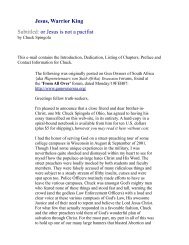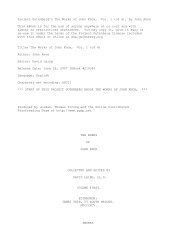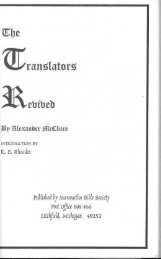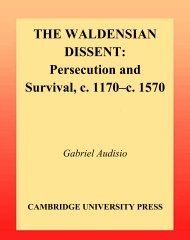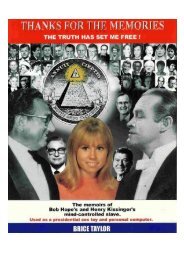THE PINK SWASTIKA - Shattering Denial
THE PINK SWASTIKA - Shattering Denial
THE PINK SWASTIKA - Shattering Denial
Create successful ePaper yourself
Turn your PDF publications into a flip-book with our unique Google optimized e-Paper software.
in Vienna under the influence of Lanz and List (Waite, 1977:91).<br />
In 1958 Wilhelm Daim, an Austrian psychologist, published a study of Lanz entitled Der Mann der<br />
Hitler die Ideen gab (“The Man Who Gave Hitler His Ideas”). In the book, Daim recounts that Lanz<br />
had met Hitler in Vienna when the latter was 20 years old. Hitler often visited occult bookstores and he<br />
used his contacts in some of them to locate Lanz after having trouble finding back issues of Ostara.<br />
While he was destitute in Vienna, Hitler “hotly defended Liebenfels’ ideas against skeptics” writes<br />
Snyder (Snyder:211). In 1932, twenty-three years after that fateful meeting, Lanz wrote, “Hitler is one<br />
of our pupils...you will one day experience that he, and through him we, will one day be victorious and<br />
develop a movement that makes the world tremble” (Cavendish:1983). This proclamation, however,<br />
did not sit well with der Fuehrer, and he had Lanz’s writings banned in 1933 (Snyder:211).<br />
Lanz’s Ostara was a focal point for racist and occult figures in Germany. In Ostara, Lanz proposed<br />
that “unsatisfactory” racial types be eliminated by abortion, sterilization, starvation, forced labor and<br />
other means. He also recommended Aryan breeding farms where a master race, destined to control the<br />
world, could be hatched (Cavendish:1983). Heinrich Himmler would later create such a breeding<br />
program (called Lebensborn) during the Third Reich. The close similarity of Lanz’s prescription for<br />
the elimination of “inferiors” to the views of Benedict Friedlander suggests the possibility of a<br />
relationship between The ONT (Order of the New Temple) and the Community of the Elite. One link<br />
was Harald Gravelle, a homosexual member of the Guido von List Society who wrote for both Ostara<br />
and Der Eigene (Steakley:67n.34). Gravelle was “the principle theosophist of Lanz’s acquaintance,<br />
with the exception of Guido List” (Goodrick-Clarke:100).<br />
Although not directly connected to the ONT, the astrologist, Dr. Karl Gunther Heimsoth was another<br />
link between the Community of the Elite and the occultists. Heimsoth, a homosexual, was “a close<br />
friend and Freikorps comrade of Roehm” and maintained “close contact with several future Nazi big<br />
wigs” (Machtan:108f). He wrote a book titled Charakter Konstellation, which was devoted entirely to<br />
the horoscopes of homosexuals (Rector:81); he was also a contributor to Der Eigene. Heimsoth is<br />
remembered for coining the term “homophile” (Oosterhuis and Kennedy:188), which was a common<br />
American synonym for homosexual in the early decades of the “gay” movement here.<br />
The Thule Society<br />
In 1912, various followers of List and Lanz formed an organization called the Germanen Order.<br />
Diverging radically from the purely philosophic and spiritual focus of the groups that the two<br />
“masters” had formed, the Germanen Order was to take an active role in fulfilling the goals of<br />
Ariosophist teachings. “The principle aim of the Germanen Order,” writes Goodrick-Clarke, “was the<br />
monitoring of the Jews and their activities by the creation of a center to which all anti-Semitic material<br />
would flow for distribution” (Goodrick-Clarke:128). Only Aryans of pure descent were allowed to<br />
become members. The first World War disrupted the organization, but in the aftermath of the war the<br />
chapters of the Order began to engage in direct action against those they considered to be their enemies.<br />
After the war the Order began to be “used as a cover organization for the recruitment of political<br />
assassins” (ibid.:133) who revived the practices of the Vehmgericht, a medieval vigilante society<br />
whose only sentence was death (Waite 1969:216ff). Prominent among these assassins were Gerhard<br />
Rossbach, Edmund Heines and other “Butch” homosexuals who would later help to shape the Nazi<br />
Party (Snyder:92, Waite:222f).<br />
Some 354 enemies of the nationalists were killed over several years in the campaign of Vheme



